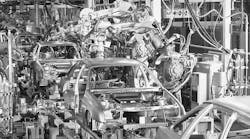That Was Then: The First Surge of Industrial Robots
Jeff Burnstein has been a part of the robotics industry since the fall of 1983, when he joined Robotic Industries Association. Today, he’s president of the Association for Advancing Automation, a nonprofit that serves as the umbrella for RIA, the AIA — Advancing Vision + Imaging, and the Motion Control & Motor Association.
What was happening back then, he said, “was robotics was going to be the next industrial revolution. There were going to be all these robots out there, artificial intelligence was a threat, and everybody was going to lose their jobs — all the same things you’re seeing today.”
Then, General Motors, which introduced its first robot on the assembly line in 1961, cancelled a handful of significant orders. “When they cancelled those orders, there were all these stories about failure and people wondered what was going to happen in the industry. You had all these big players in the market — IBM, GE, GM, Westinghouse, Bendix — and they ended up saying, We’re getting out of robotics. The market went way down and people left us for dead for a while.”
For almost two full decades, stagnation, fits and false starts. Finally, in 2005, the industry reached the use numbers it was It was supposed to hit in the early 1980s, and in the years following the Great Recession, adoption finally surged.
“And now it’s all the same stuff, all these years later,” Burnstein said. “We’re in the exact same spot from that standpoint. But now there’s growth, and the real fast growth is in China. They have government support, national plans, Made in China 2025. They are all in on robotics, and everybody else is looking at them and wondering what to do. If you can’t compete, companies in your country will be in trouble.”




